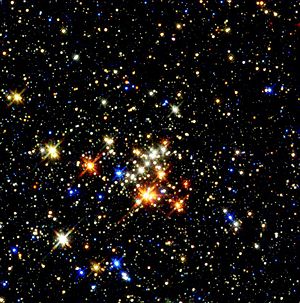WR 102ea
WR 102ea (circled) in the Quintuplet Cluster | |
| Observation data Epoch J2000 Equinox J2000 | |
|---|---|
| Constellation | Sagittarius |
| Right ascension | 17h 46m 15.12s[1] |
| Declination | −28° 49′ 36.9″[1] |
| Characteristics | |
| Evolutionary stage | Wolf Rayet |
| Spectral type | WN9h[2] |
| Apparent magnitude (K) | 8.8[3] |
| Astrometry | |
| Radial velocity (Rv) | 116[4] km/s |
| Proper motion (μ) | RA: -0.59[1] mas/yr Dec.: -1.21[1] mas/yr |
| Distance | 26k[2] ly (8k[2] pc) |
| Details | |
| Mass | 58[5] M☉ |
| Radius | 86[2] R☉ |
| Luminosity | 2.5 × 106[2] L☉ |
| Temperature | 25,100[2] K |
| Age | ~4[5] Myr |
| Other designations | |
FMM 241, qF 241, (erroneously QPM-241), Q10, MGM 5-10, LHO 71 | |
| Database references | |
| SIMBAD | data |
WR 102ea is a Wolf–Rayet star in the Sagittarius constellation. It is the second most luminous star in the Quintuplet cluster after WR 102hb. With a luminosity of 2,500,000 times solar, it is also one of the most luminous stars known. Despite the high luminosity it can only be observed at infra-red wavelengths due to the dimming effect of intervening dust on visual light.
It is an evolved massive star which has an emission line spectrum from a strong stellar wind caused by high luminosity and the presence of elements heavier than hydrogen in the photosphere. The spectrum is dominated by ionised helium and nitrogen lines due to convectional and rotational mixing of fusion products to the surface of the star. However it is still in a core hydrogen burning phase and hydrogen lines are also visible in the spectrum, in contrast to WN stars without hydrogen which are older, less massive, and less luminous. Despite being a relatively unevolved star, WR 102ea has lost over half its mass already.[5]
References
- ^ a b c d Dong, H.; Wang, Q. D.; Cotera, A.; Stolovy, S.; Morris, M. R.; Mauerhan, J.; Mills, E. A.; Schneider, G.; Calzetti, D.; Lang, C. (2011). "Hubble Space Telescope Paschen α survey of the Galactic Centre: Data reduction and products". Monthly Notices of the Royal Astronomical Society. 417: 114. arXiv:1105.1703. Bibcode:2011MNRAS.417..114D. doi:10.1111/j.1365-2966.2011.19013.x.
{{cite journal}}: CS1 maint: unflagged free DOI (link) - ^ a b c d e f Liermann, A.; Hamann, W.-R.; Oskinova, L. M.; Todt, H.; Butler, K. (2010). "The Quintuplet cluster". Astronomy & Astrophysics. 524: A82. arXiv:1011.5796. Bibcode:2010A&A...524A..82L. doi:10.1051/0004-6361/200912612.
- ^ Liermann, A.; Hamann, W.-R.; Oskinova, L. M. (2009). "The Quintuplet cluster". Astronomy and Astrophysics. 494 (3): 1137. arXiv:0809.5199. Bibcode:2009A&A...494.1137L. doi:10.1051/0004-6361:200810371.
- ^ Liermann, A.; Hamann, W.-R.; Oskinova, L. M. (2009). "The Quintuplet cluster. I. A K-band spectral catalog of stellar sources". Astronomy and Astrophysics. 494 (3): 1137. arXiv:0809.5199. Bibcode:2009A&A...494.1137L. doi:10.1051/0004-6361:200810371.
- ^ a b c Liermann, Adriane; Hamann, Wolf-Rainer; Oskinova, Lidia M.; Todt, Helge (2011). "High-mass stars in the Galactic center Quintuplet cluster". Société Royale des Sciences de Liège. 80: 160. Bibcode:2011BSRSL..80..160L.

